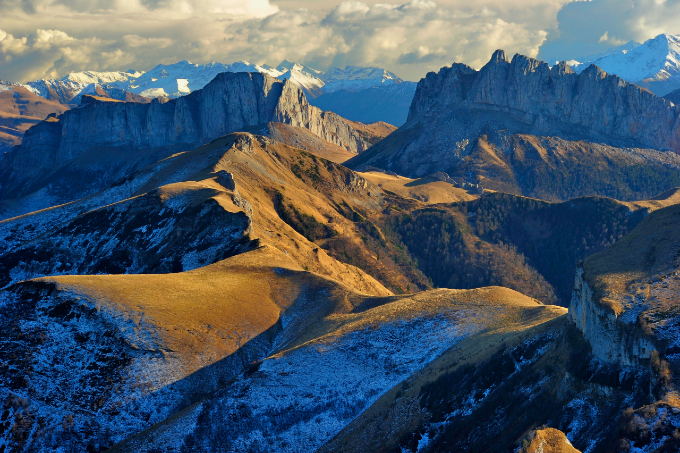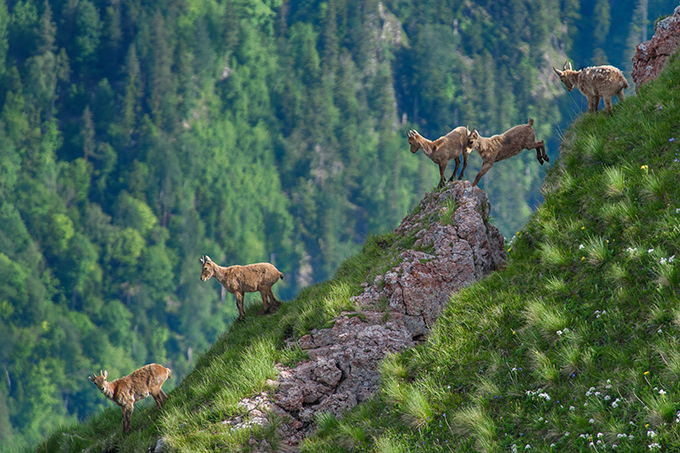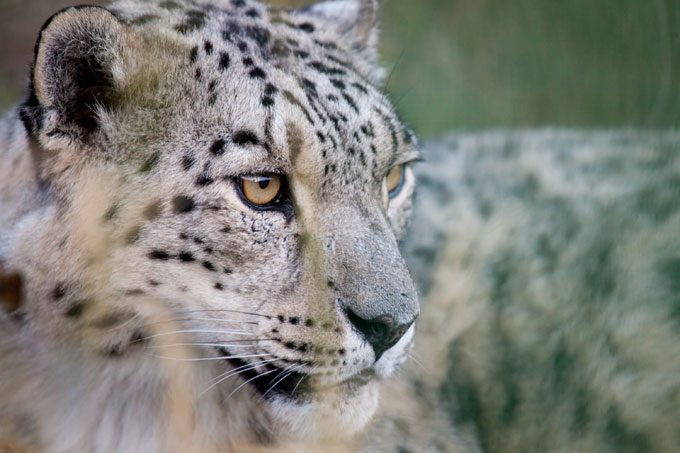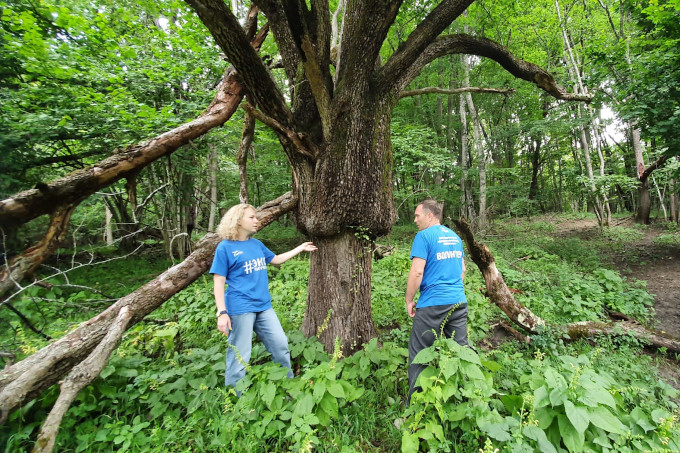Mountains - Vulnerable giants
NABU's work to defend alpine ecosystems

NABU works to defend biodiversity in vulnerable alpine regions. - photo: Sergei Trepet
Exceptionally rich biodiversity is one of the most remarkable traits of alpine ecosystems. While accounting for less than 25 percent of the land area, mountain ranges support an estimated third of terrestrial biodiversity and host about half of the world’s biodiversity hotspots, as well as 10 percent of the world's population. The most diverse hotspots are the Tropical Andes, which alone contain more than 15 percent of all plant life on the planet. One of the key factors contributing to mountain biodiversity is environmental heterogeneity. Mountains encompass a wide range of climatic and topographic conditions across short geographic distances, resulting in high habitat diversity and allowing more species to coexist than would otherwise be possible.
Sources of water and life
Mountains not only host an outsized share of the world’s biodiversity, but also provide ecosystem services that extend beyond their geographical boundaries. All major rivers in the world – from the Rio Grande to the Nile – have their headwaters in highlands, and half of humankind relies on the freshwater that accumulates in mountain areas. Even in temperate areas, 30 to 60 percent of freshwater can come from highland watersheds. In the Rhine basin, for example, the Alps provide 31 percent of annual flows, even though they make up only 11 percent of the basin’s land area. In semi-arid and arid regions, mountain discharge can represent up to 95 percent of the total flow in a catchment. The high mountains of Asia, which include the Himalayas, the Karakoram, the Hindu Kush, and the Tibetan Plateau, store more frozen water than anywhere else in the world outside the polar regions. For this reason, the region is often referred to as the Third Pole.
Along with essential ecosystem services, mountains provide income, a sense of identity, and spiritual values to people and communities all over the world. As the highest features of the landscape, mountains may serve as natural temples, places of worship, inspiration, and transformation. Many religions have traditions centred on sacred mountains which are considered holy (such as Mount Olympus in Greek mythology) or are related to famous events (like Mount Sinai in Abrahamic religions). Because of their outstanding natural and cultural values, many mountains and mountainous areas have been designated as World Heritage sites.
Growing threats

Species inhabiting mountainous ecosystems are perfectly adapted to the harsh living conditions. - photo: Dmitry Andreev
Although they may appear eternal and everlasting, mountains are experiencing rapid changes and are among the most vulnerable landscapes on Earth. The main drivers of mountain landscape transformation are land use and climate change. Unsustainable land use practices, namely overgrazing, deforestation, and non-conservation agriculture, result in the degradation of natural habitats and create niches for invasive species. Other significant threats are the development of large-scale infrastructure and unsustainable natural resource projects, the most considerable being hydrocarbon exploration and mining activities. Linear infrastructure, such as pipelines, fences, and roads, including the roads required to access mining sites, cut through natural habitats and disrupt animal movement, leading to declining populations of many wildlife species. In addition, improved access for humans can lead to an increase in wildlife poaching. The remoteness and vast scale of mountainous areas make it difficult to control illegal activities, even more so as many mountain ranges constitute geopolitically sensitive international border areas.
The effects of land use are further aggravated by climate change, which is reported to be occurring more rapidly in mountains than in any other ecosystem outside of the Arctic and Antarctic. Iconic symbols of the changing climate are the diminishing glaciers on Africa’s highest mountain, Kilimanjaro. Of the ice cover recorded in 1912, 85 percent has already disappeared, and most of what remains could be gone by 2033. At the same time, mountain ecosystems are particularly sensitive to climate warming since their biota is generally adapted to lower temperatures. As cold habitats are often restricted to small summits, alpine species may not have sufficient suitable habitat to survive rapid changes. This scenario is known as “nowhere to go”.
Asia in focus
Although found on every continent including Antarctica, mountain ranges are not homogeneously distributed around the globe. All of the world’s mountains above 7,000 metres are in Asia, and all peaks above 8,000 metres, including the highest, Mount Everest, are situated in the Greater Himalayan range.
Moving mountains for mountain conservation
Over the last few decades, mountains have received increasing attention from the scientific, environmental, and political communities. The global importance of mountains was first officially recognized by the United Nations in 1992 in Agenda 21, a global action plan for sustainable development into the 21st century. Chapter 13 of Agenda 21 emphasizes the role of mountains as fragile ecosystems that matter for humankind.
In line with global environmental trends, NABU has been committed to the protection of mountain biodiversity since the mid-1990s. Internationally, we have focused particularly on the mountain biodiversity hotspots in the Caucasus and the highlands of Central Asia. In the Caucasus, NABU works with partners and local communities to preserve the unique natural treasures of the region – from the robust fruit variations cultivated in Circassian orchards in Armenia in the South Caucasus to the last remaining Caucasian bisons in the North Caucasus. To protect the biodiversity and precious habitats of these mountainous regions, one of NABU’s main priorities is to promote environmental education and sustainable regional development.

NABU conservation projects - photos: NABU Kavkaz, NABU Kyrgyzstan, BWCDO; illustration: Julia Friese
Protecting the snow leopard as a flagship species
In Central Asia, NABU’s work is focused on and around the snow leopard – a flagship species of sensitive high mountain ecosystems. On NABU’s initiative, the Global Snow Leopard Conservation Forum, held in 2013 and 2017, brought together the 12 home countries of the snow leopard for joint conservation efforts. In addition to such cross-national efforts, NABU actively supports local organizations for wildlife protection in Tajikistan, Pakistan, Nepal, Bhutan, Mongolia and Kyrgyzstan.
In Kyrgyzstan, NABU has supported nature conservation programmes for decades. One example of NABU’s nature conservation activities is the Ilbirs rehabilitation centre for wild animals in the Terek valley in the Talai region. Anti-poaching work carried out in collaboration with the government of the Kyrgyz Republic has substantially reduced poaching rates in the country. The anti-poacher unit Gruppa Bars, launched and supported by NABU, is on a mission to protect wild animals by seizing illegal weapons, traps and skins. Animals rescued from poachers, such as snow leopards, lynx and birds of prey, are given veterinary treatment in the rehabilitation centre in Terek and returned to the wild if possible.
"Preserving the richness of mountain ecosystems and improving people’s living conditions should go hand in hand."
Katja Kaupisch, NABU Head of Central Asia and Eastern Europe Programme
As well as measures that directly contribute to the protection of the snow leopard and its habitats, NABU’s local office in Kyrgyzstan monitors the species population and carries out ecological education work, with up to 200 events, courses and other participatory activities per year. Since 2002, the office in Bishkek has been a major partner for the implementation of local NABU projects and is now considered to be the most important association for nature and species conservation in Kyrgyzstan. The 30 full-time employees and 50 volunteers are key partners for the Kyrgyz government and perform nationwide ecological monitoring programmes on its behalf.
SELECTED PROJECTS
The mountains of Armenia belong to the Caucasus biodiversity hotspot and are unique in both natural and cultural heritage. With the project "Creative Mountains", NABU and its partners seek to promote conservation and sustainable development in local communities. more →
Snow leopards are among the most endangered big cats on earth. Only 4,000 to 6,400 animals now live in the wild. NABU has been committed to the survival of snow leopards in Kyrgyzstan since 1999 and has extended its commitment to Tajikistan, Pakistan and Nepal. more →
The Circassian orchards in the North Caucasus are living witnesses to an almost forgotten tradition of fruit cultivation. NABU worked with the local population to protect these valuable habitats and encourage the revival of this traditional land use. more →



